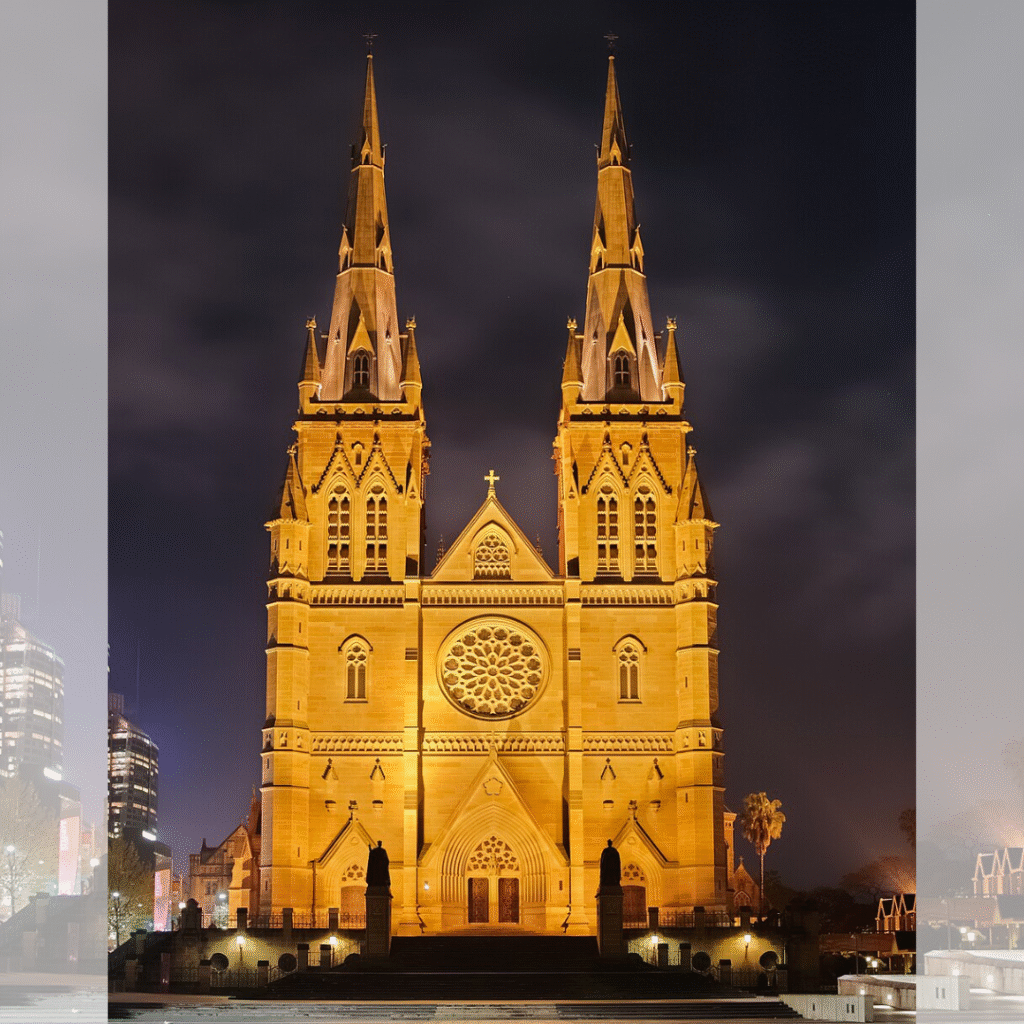
The stained‑glass windows of St Mary’s Cathedral, Sydney were crafted over five decades from 1881 by the renowned Hardman & Co. of Birmingham. Therefore, bringing a refined Gothic Revival aesthetic from England to Australia. Shipped in the late 1880s, they were installed progressively throughout the cathedral. Each piece contributing to the overall theological narrative and visual harmony of the sacred space .
Sanctuary & Transept Windows: The Mysteries of the Rosary
Dominating the sanctuary and transepts are windows depicting the 15 Mysteries of the Rosary, leading up to the crowning grandeur of the Great North Window. Hence, this portrays the Coronation of the Blessed Virgin Mary as Queen of Heaven and Earth. This window is a masterpiece of symbolic richness surrounded by a celestial choir in blue robes (Mary’s symbolic color), virgin saints, New Testament figures, and male saints who championed devotion to Mary.
Nave Windows: New Testament & Sydney’s Early Church
Along the nave, approximately 40 windows illustrate key New Testament events—Jesus’ birth, childhood, teachings, and passion. The first four on each side are particularly special: they commemorate moments in Sydney’s early Catholic history, preceding the cathedral’s completion. These windows weave together sacred scripture and local identity in vibrant color.
Chapel Windows: Saints & Founders
In the subsidiary chapels, the glasswork informs both devotional devotion and institutional memory. They include:
- Chapel of the Irish Saints, featuring the Polding Window (1901–1946), showing St Gregory dispatching St Augustine to England, with roundels of bishops Polding, Ullathorne, and Davis in medieval.
- Other chapels portray themes like Sacred Heart, St Joseph, St Peter, St Patrick & St Brendan, and a tribute to Cardinal John Henry Newman.
Rose Windows: Symbolism & Craft
Above the main entrances and transepts are the cathedral’s magnificent rose windows. The west transept rose shows Adam, Old Testament prophets, patriarchs. The east transept centers on Christ, St John the Baptist, and the four Evangelists. The south transept features St Peter alongside 16 Popes completing all the four sides. These circular wonders not only enhance aesthetic beauty but echo the Gothic tradition of Marian symbolism. Hence, rose windows becoming visual prayers to Christ and the Virgin .
Evolution of Style & Liturgical Function
The cathedral’s stained glass spans the styles of 19th‑century Gothic Revival to early 20th‑century painterly richness. Hence, reflecting changes in ecclesiastic art. This progression offers a visual timeline of craftsmanship, theological emphasis, and artistic technique within a single sacred edifice.
Light, Colour & Conservation
Lighting at St Mary’s is a study in thoughtful contrast: the clerestory was glazed with yellow glass to soften bright Australian sunlight, now darkened over time, contrasting with the stained glass below. A major lighting overhaul in the 1970s ensured even illumination across panels and vaults—maintaining visual impact without compromising structure. Maintenance efforts since 1995 have ensured their continued vibrancy and structural integrity.
Spiritual & Artistic Legacy
These windows are more than decorative—they offer catechetical storytelling. Each scene, figure, and color serves as a visual sermon, illuminating doctrine, devotion, and tradition. For pilgrims, worshippers, historians, and art lovers alike, they offer an immersive experience. Therefore, blending theology, aesthetics, and local significance under a tapestry of light. The crowning Great North Window stands out as one of the premier 19th‑century stained‑glass masterpieces globally.
St Mary’s Cathedral Sydney
This stained‑glass ensemble is a profound synthesis of faith and artistry. From the mysteries of the Rosary to local milestones, from majestic rose windows to sanctuary sanctity, each panel speaks in color and light. Hence, creating an enduring testament to devotion, craftsmanship, and the unfolding narrative of the Church in Australia.

It seems magnificent phrase to me is
Yes, It truly is magnificent.
I can not take part now in discussion – there is no free time. Very soon I will necessarily express the opinion.